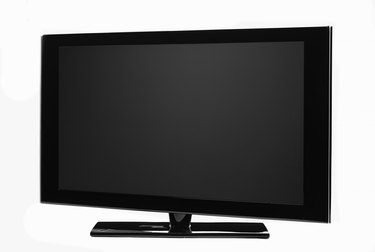
Liquid-crystal display televisions, or LCD TVs, utilize two layers of glass. The glass holds fluid crystal that creates images with the help of an electrical current and external light source, or backlight. The goal is to develop a sharper image on your screen, but the intricacy of the components can lead to problems with the picture quality.
Solarization
Video of the Day
Solarization is a phenomenon often seen with LCD televisions. It causes discoloration of the tones, especially skin tones, on the screen. Faces may appear sunburned or blotchy. The cause of solarization is complex, but it has to do with reverse negative images. There is not much you can do to fix this problem. It is a natural effect of the design. Better quality LCD TVs will have fewer issues with solarization. If you have a serious case, a service center can update the firmware in your television. That may improve the tone quality of your images.
Video of the Day
Dead Pixels
Dead pixels are little bits of stuck color on the screen. Images are made with three primary colors; red, blue and yellow. To create secondary colors such as green, two or more of the primary colors must meld together. When you see a dead pixel, one of the primary colors sticks on the screen instead of changing based on the image. That pixel on the TV looks dead. To fix this, you can tap the dead zone gently with a pencil eraser. The goal is to free that small piece of stuck color.
Shadows
When the settings are not quite right on the LCD TV, you may see shadows trailing anything moving on the screen. This is a sign that you need to adjust the sharpness of the display. How you go about this depends on the model of LCD you own. For many, you can open an on-screen menu with the remote. Locate the sharpness setting and turn it down. This may be a process of trial and error. Turn the sharpness down and then watch the TV for awhile. If necessary, you can continue to turn the level down until the shadows disappear.
Backlight
Backlight is an essential part of the function on the television. Without it, the crystal continues to create the image, but you can't see it. A failing backlight is easy to recognize. You may turn the TV on, and it appears to work for a short time. The image will just suddenly disappear as the light shuts off. When you see this happening on a regular basis, take the television in for service. The external light can be replaced and the TV saved from the junk pile.